

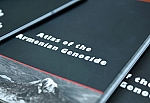 |
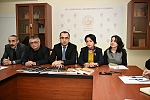 |
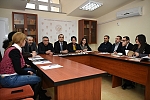 |
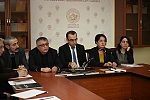 |
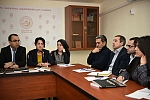 |
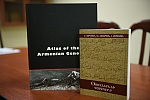 |
The presentation of the Atlas of the Armenian Genocide in English language compiled by IAS Laboratory of Armenian Historical Geography and Cartography after Babken Harutyunyan and the University Textbook of Ottoman Language compiled by IAS Department of Armenian-Ottoman Relations was held at YSU Institute for Armenian Studies, on December 21, 2017.
The opening speech was delivered by the deputy director of YSU IAS, Mher Hovhannisyan. He touched upon the preparation of Atlas during these months, noting that a book with such volume and content has been published for the first time since the independence of Armenia.
“The publication of Atlas was not an end in itself and it’s unique in its nature. We aimed at providing the English-language speaking researchers, officials as well as people who are interested in the issue of the Armenian Genocide with the opportunity to study this theme. In the near future, we expect the Atlas to be published in other foreign languages,” - said Mher Hovhannisyan.
The head of Laboratory of Armenian Historical Geography and Cartography after Babken Harutyunyan, Vardan Mkhitaryan spoke about the content of the Atlas. He said that the book presents various issues and historical events related to the Armenian Genocide: the Armenian-Turkish war, Hamidian massacres, the massacres of eastern Armenians, May victories, massacre of Armenians in Baku, cultural, Diaspora formation etc. Atlas also includes agreements, documents and pictures. At the same time, the role of Armenians in the Ottoman Empire and the Russian Empire is presented. In the last part of the Atlas there is also a reference to the international recognition and condemnation of the Genocide.
The author mentioned that representatives of the faculties of History, Geography and Geology, employees of the Institute for Armenian Studies (IAS), as well as the Armenian Genocide Museum-Institute participated in the work of the preparation of the Atlas. The chief editor of the book is YSU rector, Doctor in Historical Sciences, Professor Aram Simonyan.
The next work that was presented was the University Textbook of Ottoman Language. Mher Hovhannisyan spoke about the issues Ottoman language teaching. “Ottoman language teaching is very important today. Many documents referring to the Armenian Genocide were written in this language and we want to prepare specialists for further research who will be able to carry out extensive and comprehensive documentary studies in the Ottoman language.
The members of the textbook authoring group, employees of IAS Department of Armenian-Ottoman Relations, professor Alexander Safaryan, candidate in philological sciences Lusine Sahakyan and candidate in philological sciences Ani Sargsyan spoke about the textbook during the presentation.
“In the newly-independent Armenia, YSU, and especially in IAS, good amount of work has been done in the field of Ottoman language study and textbook-making activities. The importance of the Ottoman language textbook was evident in Armenian universities and different communities of Diaspora. So far, we have used textbooks and manuals by various foreign universities to teach the Ottoman language. In this textbook we have presented the traditions and history of Armenian Ottoman studies” - said Alexander Safaryan.
Lusine Sahakyan, head of the department of Armenian-Ottoman Relations, in her turn spoke about the preparation of the textbook. She pointed out that special attention was paid to Ottoman language teaching methods and principles in order to make the textbook understandable for students.
“I am convinced that any student who learn this language through this textbook will be able to conduct research on Ottoman documents and do quality translations”, - noted L. Sahakyan.
The co-author of the Ottoman language textbook, Ani Sargsyan presented the structure of the book. “The textbook consists of 32 lessons. During one academic year, the student can study the grammar of the Ottoman language and get acquainted with the texts of the two periods and will be able to do translations. In the near future, we intend to devote our next work to the creation of the manual of Ottoman documents translation.
Ani Sargsyan mentioned that the textbook has generated great interest among Ottoman scholars in Greece and Turkey. She noted that there is already one peer-review by the Ottoman studies specialist of Istanbul University and will soon be published in the Istanbul University's newspaper.
Summing up the event, Mher Hovhannisyan thanked the authoring group of the two books.
Back
















